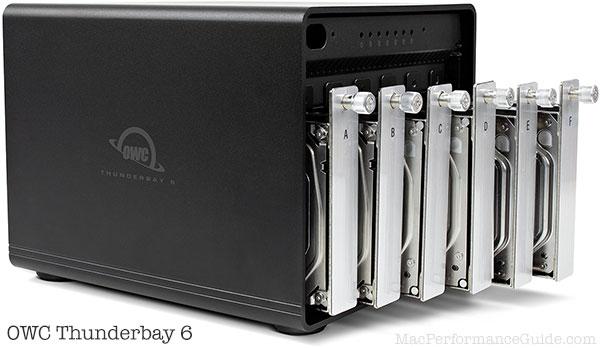
$220 SAVE $130 = 37.0% Western Digital 16.0TB Western Digital Ultrastar DC HC550 3.5-in… in Storage: Hard Drives
|

|

|

|

|

|

|

|

|

|
OWC Thunderbay 6 vs Thunderbay 4: RAID-5 Performance Options
Related: bandwidth, hard drive, Other World Computing, OWC Thunderbay, OWC ThunderBay 6, RAID, RAID-5, storage, Thunderbolt, Thunderbolt 3, Toshiba, weather events
Configurations up to 84TB. Available in RAID edition (includes SoftRAID XT) or standard edition.
This pages complements the RAID-5 test results; see the testing details on that page.
As discussed, the OWC Thunderbay 4 has greater total bandwidth than the OWC Thunderbay 6, but the Thunderbay 4 houses only four drives. Since hard drives slow down as they fill up, what if just one additional drive is used (five drives total) in the Thunderbay 6? There are plusses and minuses:
- Option for a 6th drive, or leave the 6th bay free.
- Single compact unit for all drives is a win for the Thunderbay 6 (versus cabling and powering dual Thunderbay 4 units).
- For the same 42TB capacity, increased performance with five drives because hard drives slow down as they fill up. With a 5th drive, the 42TB RAID-5 volume is using substantially faster areas of the (five) drives, versus the entire capacity of only 4 drives. The win is substantial, as the graph below shows.
- Additional 14TB of capacity in the 5-drive configuration can be left unused or put to another use.
- Downside: about 30% higher cost for a Thunderbay 6 with 5 drives versus Thunderbay 4.
Using four 14TB drives in the OWC Thunderbay 4 results in a 42TB volume. Using five 14TB drives yields a 56TB volume or a notably better performing 42TB volume.
Test results, RAID-5 with 4/5/6 drives —Thunderbay 4 vs Thunderbay 5
Like all hard drives, the outer tracks are much faster than the inner tracks; see Drive Capacity and Speed. Hence the speed across capacity steadily declines as expected behavior.
The sweet spot of using five drives in the OWC Thunderbay 6 is seen below in the middlepair of orange/blue lines.
Using five drives in the OWC Thunderbay 6 for 42TB of capacity sees huge gains versus four drives in the OWC Thunderbay 4 (middle pair of orange/blue lines vs red/green pair).
Capacity utilization of a 42TB volume is surely more than a few terabytes, so the most relevant performance is at least 25% full and beyond (25 to 100 range). In that range, the 5-drive RAID-5 hugely outperforms the 4-drive RAID-5 by a large margin.
The cost difference is about $200 for the enclosure and the cost of one additional drive. The same behavior should hold for any capacity drive. My thinking is thus that in spite of its bandwidth limitations, the OWC Thunderbay 6 with a 5-drive RAID-5 is the sweet spot (I’ll use the sixth drive for backups).
Going to six drives, anyone would wish to see the OWC Thunderbay 6 bandwidth limitations not drag performance down but the simple fact is that for equal capacity of 42TB, using 5 or 6 drives in the Thunderbay 6 hugely outperforms the OWC Thunderbay 4.
- The red (write) / green (read) lines are the OWC Thunderbay 4 unit with four 14TB drives.
- The three pairs of orange (write) blue (read) lines for for the OWC Thunderbay 6 with 4, 5, 6 drives respectively. The highest lines are for the 6-drive RAID-5, next highest the 5-drive RAID-5, lowest lines are 4-drive RAID-5.
Vertical scale is MB/sec. Horizontal scale shows percentage of volume capacity, e.g., 50% of an 42TB volume is the 21TB mark. All test values were across a 42TB volume with excess space left unused for the 5 and 6 drive RAIDs.

Seagate 22TB IronWolf Pro 7200 rpm SATA III 3.5" Internal NAS HDD (CMR)
SAVE $100

 diglloydTools™
diglloydTools™


